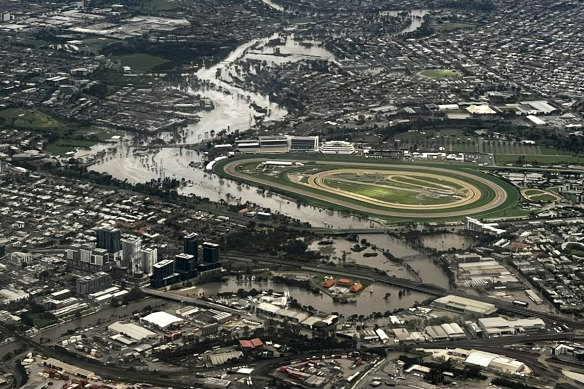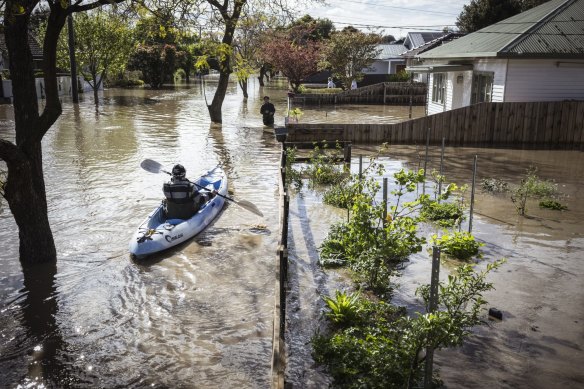By Sophie Aubrey
The Flemington Racecourse flood wall raised water levels for at least 240 homes in Maribyrnong during the 2022 inundation disaster, but the impacts were not significant enough to justify tearing it down.
The final Melbourne Water report into the Maribyrnong River flood, which focused specifically on the impacts of Flemington Racecourse’s 2.4-metre wall, found it increased flood levels by 0.8 centimetres to three centimetres in some residential areas and lengthened its duration.

The Flemington Racecourse flood wall kept the track in perfect condition while Maribyrnong homes flooded.Credit: Emma Johnston
The report, released on Friday, concluded that some properties “most likely” flooded that would not have done so without the wall.
In industrial parts of West Melbourne and Kensington, the flood level in October 2022 was six centimetres higher than it would have been had the wall not been built.
The review panel, chaired by Justice Tony Pagone, assessed new modelling by technical consultants Jacobs, and found that the flood level in several locations significantly exceeded the one centimetre considered to be a generally acceptable impact of a development.
The report noted that while an impact of more than one centimetre might be acceptable for projects of wide societal benefit, the principle guiding the construction of the wall by Victoria Racing Club in 2007 was that any adverse impacts “must be identified and prevented”.
The type of damage that may have been caused by the flood wall includes destroyed furniture, skirting boards, electrical work and stock losses for businesses.
Melbourne Water managing director Dr Nerina Di Lorenzo said the wall’s impact on homes, which flooded by an average of 80 centimetres during the event, did not justify pulling it down. “The evidence doesn’t support removal of the wall, given that the average impact on residential property was 1.7 centimetres,” she said.
The report also found that mitigation works built to offset the effects of the flood wall had a negligible protective impact on the flooding in residential areas.
Di Lorenzo acknowledged that the mitigation works did not perform as well as expected and said the water agency was now examining the possibility of future physical works such as levees and pipe work, as well as improved flood emergency management.
Friday’s report was the final and much-anticipated part of Melbourne Water’s review after the racecourse wall sparked widespread community anger when the track remained pristine as residents waded through their muddied homes.
Maribyrnong resident Antoinette Bufalino, who was flooded in October 2022 and is a member of the Maribyrnong Community Recovery Association, was shocked by the report findings and called for the wall to be pulled down.
Bufalino has lived opposite the Maribyrnong River for 22 years and she felt it was impossible that the flood wall’s impacts weren’t more severe. “That wall has changed everything. They don’t want to hear what we have to say,” she said.
The racecourse wall has long been a point of tension for the community. It was built after Labor’s then planning minister Mary Delahunty overturned a bid by the Maribyrnong, Melbourne and Moonee Valley councils to block it, supported by a fierce resident campaign.
The flood wall was approved with Melbourne Water modelling showing that it wouldn’t increase the risk to people and property if certain compensatory steps were taken.
Di Lorenzo said she couldn’t comment on decisions made almost 20 years ago. “That was a model that was completed before the time of the iPhone but that was the best information at that time,” she said.
“We have much better information today and we’ve got 20 years of development.”
A Victoria Racing Club spokeswoman said the organisation would be reviewing the findings of the report.
“Approval for the flood wall and flood mitigation works was obtained in 2004, subject to a number of conditions, and these works were completed in 2007 in accordance with the approvals granted and complied with all relevant requirements,” she said.
“We remain committed to working with the appropriate authorities on this matter.”
Victorian Greens leader Ellen Sandell called on the state government to demand the racecourse wall be removed.
“People in Kensington and Maribyrnong should be furious at the Labor state government for approving the racecourse flood wall, as this report shows clearly that it did worsen the floods,” she said.
The flood review panel’s initial report, released in October, recommended Melbourne Water conduct more regular reviews of flood models, called for improvements to forecast and warning systems, suggested property buybacks might be needed and found that the flood risk at Rivervue retirement village in Avondale Heights, where 47 properties were inundated, could worsen with climate change.
Melbourne Water this week also released new flood modelling for the Maribyrnong River catchment, predicting the risk today and in the year 2100. The most significant changes are to some residential areas of the suburbs of Maribyrnong and Kensington.
The Melbourne Water review, ordered by former premier Daniel Andrews, was criticised last year because of a perceived lack of independence and because of the limited scope of its terms of reference, with matters such as emergency responses, flood recovery and urban planning excluded.

The flooded streets of Maribyrnong in October 2022 after the river burst its banks.Credit: Chris Hopkins
A wider-ranging flood parliamentary inquiry was later established after extensive reporting by The Age and the backing of Coalition, Greens and crossbench MPs.
The October 2022 flood hit more than 600 homes and businesses across Maribyrnong, Avondale Heights, Kensington and Ascot Vale. It was the third-worst flood on record for the Maribyrnong River; only floods in 1974 and 1906 have hit the area harder.
The Morning Edition newsletter is our guide to the day’s most important and interesting stories, analysis and insights. Sign up here.
https://news.google.com/rss/articles/CBMijAFodHRwczovL3d3dy50aGVhZ2UuY29tLmF1L25hdGlvbmFsL3ZpY3RvcmlhL2ZsZW1pbmd0b24tcmFjZWNvdXJzZS1mbG9vZC13YWxsLXdvcnNlbmVkLW1hcmlieXJub25nLWRpc2FzdGVyLXJlcG9ydC1maW5kcy0yMDI0MDUwMy1wNWZvbmMuaHRtbNIBAA?oc=5
2024-05-03 01:04:11Z
CBMijAFodHRwczovL3d3dy50aGVhZ2UuY29tLmF1L25hdGlvbmFsL3ZpY3RvcmlhL2ZsZW1pbmd0b24tcmFjZWNvdXJzZS1mbG9vZC13YWxsLXdvcnNlbmVkLW1hcmlieXJub25nLWRpc2FzdGVyLXJlcG9ydC1maW5kcy0yMDI0MDUwMy1wNWZvbmMuaHRtbNIBAA
Bagikan Berita Ini














0 Response to "Flemington Racecourse flood wall worsened Maribyrnong disaster, report finds - The Age"
Post a Comment